Related Research Articles
The term soke, at the time of the Norman conquest of England, generally denoted "jurisdiction", but its vague usage makes it probably lack a single, precise definition.
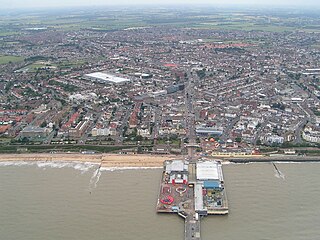
Tendring District is a local government district in north-east Essex, England. It extends from the River Stour in the north, to the coast and the River Colne in the south, with the coast to the east and the city of Colchester to the west. Its council is based in Clacton-on-Sea. Towns in the district include Frinton-on-Sea, Walton-on-the-Naze, Brightlingsea and Harwich. Large villages in the district include St Osyth and Great Bentley.

Walton-on-the-Naze is a seaside town on the North Sea coast and a former civil parish, now in the parish of Frinton and Walton, in the Tendring district in Essex, England. It is north of Clacton and south of the port of Harwich. Frinton-on-Sea is to the south of the town. The town has a population of 12,054. In 1931 the parish had a population of 3071. It attracts many visitors, The Naze being the main attraction. There is also a pier.
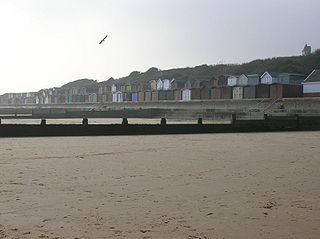
Frinton-on-Sea is a seaside town and a former civil parish, now in the parish of Frinton and Walton, in the Tendring district of Essex, England. In 2018 it had an estimated population of 4,837. In 1931 the parish had a population of 2196.

Thorpe-le-Soken is a village and civil parish in the Tendring district of Essex, England located east of Colchester, west of Walton-on-the-Naze, Frinton-on-Sea and north of Clacton-on-Sea.

The Sunshine Coast Line is the current marketing name of what originally was the Tendring Hundred Railway Line, a branch off the Great Eastern Main Line in the East of England. It links Colchester to the seaside resorts of Clacton-on-Sea and, via a branch, Walton-on-the-Naze. The line is part of the Network Rail Strategic Route 7, SRS 07.08, and is classified as a London & South East commuter line. Passenger services on the line are currently operated by Greater Anglia.
Frinton and Walton is a civil parish in the Tendring district of Essex, England.

Weeley railway station is on the Sunshine Coast Line, a branch of the Great Eastern Main Line, in the East of England, serving the village of Weeley, Essex. It is 62 miles 78 chains (101.3 km) down the line from London Liverpool Street and is situated between Great Bentley to the west and Thorpe-le-Soken to the east. Its three-letter station code is WEE.

Wivenhoe railway station is on the Sunshine Coast Line, a branch of the Great Eastern Main Line, in the East of England, serving the small town of Wivenhoe, Essex. It is 56 miles (90 km) down the line from London Liverpool Street and is situated between Hythe to the west and Alresford to the east. Its three-letter station code is WIV.

Thorpe-le-Soken railway station is on the Sunshine Coast Line, a branch of the Great Eastern Main Line, in the East of England, serving the village of Thorpe-le-Soken, Essex. It is 65 miles 7 chains (104.7 km) down the line from London Liverpool Street. Its three-letter station code is TLS. To the west the preceding station is Weeley and to the east the following stations are Clacton-on-Sea on the single-stop Clacton branch or Kirby Cross on the branch to Walton-on-the-Naze.

Clacton-on-Sea railway station is one of the two eastern termini of the Sunshine Coast Line, a branch of the Great Eastern Main Line, in the East of England, serving the town of Clacton-on-Sea, Essex. It is 69 miles 56 chains (112.17 km) down the line from London Liverpool Street. Its three-letter station code is CLT. The preceding station on the line is Thorpe-le-Soken.
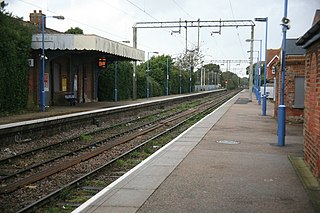
Kirby Cross railway station is on the Walton branch of the Sunshine Coast Line in the East of England, serving the village of Kirby Cross, Essex. It is 67 miles 55 chains (108.9 km) down the line from London Liverpool Street and is situated between Thorpe-le-Soken to the west and Frinton-on-Sea to the east. Its three-letter station code is KBX.

Frinton-on-Sea railway station is on the Walton branch of the Sunshine Coast Line in the East of England, serving the seaside town of Frinton-on-Sea, Essex. It is 68 miles 66 chains (110.8 km) down the line from London Liverpool Street and is situated between Kirby Cross to the west and Walton-on-the-Naze to the east. Its three-letter station code is FRI.

Walton-on-the-Naze railway station is one of the two eastern termini of the Sunshine Coast Line, a branch of the Great Eastern Main Line, in the East of England. It serves the seaside town of Walton-on-the-Naze, Essex. It is 70 miles 15 chains (113.0 km) down the line from London Liverpool Street. Its three-letter station code is WON. The preceding station on the line is Frinton-on-Sea.

Little Clacton is a village and civil parish in the Tendring district, in the county of Essex, England. It is located on the Tendring Peninsula, close to Clacton-on-Sea. The population of the parish at the 2011 census was 2,822.
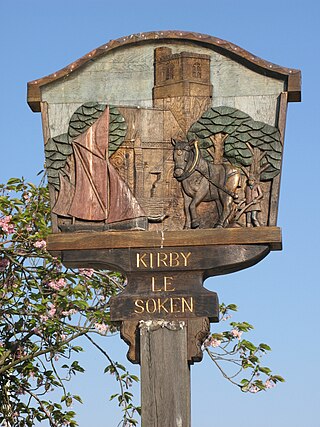
Kirby-le-Soken is a village and former civil parish, now in the parish of Frinton and Walton, in the Tendring district of North East Essex, England, which is mainly agricultural, but increasingly residential, near Frinton-on-Sea and Walton-on-the-Naze. In 2018 the built-up-area had an estimated population of 1387. In 1931 the parish had a population of 836. On 1 April 1934 the parish was abolished to form "Frinton and Walton", part also went to Thorpe le Soken.

The Red Crag Formation is a geological formation in England. It outcrops in south-eastern Suffolk and north-eastern Essex. The name derives from its iron-stained reddish colour and crag which is an East Anglian word for shells. It is part of the Crag Group, a series of notably marine strata which belong to a period when Britain was connected to continental Europe by the Weald–Artois Anticline, and the area in which the Crag Group was deposited was a tidally dominated marine bay. This bay would have been subjected to enlargement and contraction brought about by transgressions and regressions driven by the 40,000-year Milankovitch cycles.
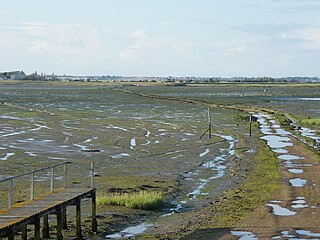
Horsey Island is an island in the parish of Thorpe-le-Soken, Essex. It lies in Hamford Water and is part of the Hamford Water National Nature Reserve, managed by Natural England. Permission is required to visit.

Hamford Water is a 2,185.8-hectare (5,401-acre) biological Site of Special Scientific Interest between Walton-on-the-Naze and Harwich in Essex. The site is a tidal inlet which has marsh grasslands, creeks, mud and sand flats, salt marshes, islands and beaches. It is described by Natural England as "of international importance for breeding little terns and wintering dark-bellied brent geese, wildfowl and waders, and of national importance for many other bird species." Rare plants include hog's fennel and slender hare's-ear. The main invertebrates are worms and thin-shelled molluscs. The largest island, Horsey Island, can be reached on foot at low tide across The Wade from Kirby-le-Soken.
References
- Johnson, Irene (1982). Turning point: the story of Kirby le Soken, Essex, 1823 to 1862. London: Regency Press. ISBN 0-7212-0651-4.
- Pigot (1839). Pigot's Directory Essex.
- Thornton, Chris (2007). Victoria County History, Essex XII (Work in Progress) - Landownership: the Sokens . Retrieved 6 August 2011.
- Wood, Ernest A. (1975). A history of Thorpe-le-Soken to the year 1890. Thorpe-le-Soken: T.C.Webb Esq. ISBN 0-9504333-0-6.